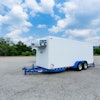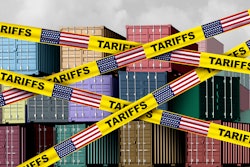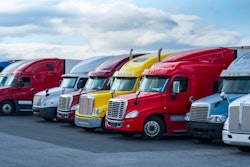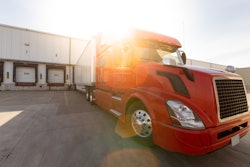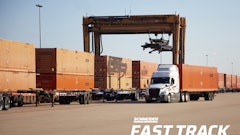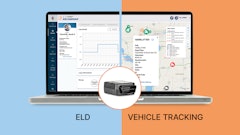
In the food and beverage industry, precision isn’t optional. It’s everything. Products must move swiftly and safely from farms to processing plants, through cold storage and distribution centers, and finally, to retailers and restaurants. Supply chain leaders invest millions in optimizing transportation, warehouse management, and inventory systems.
Yet one critical link remains disconnected: yard operations.
Behind every distribution center or manufacturing facility lies a yard operation managing the flow of trailers, yard trucks, and both raw and finished goods. When managed effectively, the yard serves as a strategic link between transportation and warehousing. When neglected or treated as a tactical afterthought, it becomes a source of bottlenecks, delays, and rising costs.
Unfortunately, that’s exactly where many food enterprises remain today, stuck at Step 1: legacy yard management.
Step 1: Where most food shippers get stuck
Many organizations still treat yard operations as a set of reactive tasks: checking in trucks, moving trailers to docks, and preventing congestion. These are essential functions, but they only scratch the surface.
Typical signs of basic yard management:
- Gate operations handled manually or via standalone applications
- Spotting services contracted out to regional or inconsistent vendors
- Trailer tracking done with clipboards or siloed software
- Dock scheduling driven by urgent, ad hoc needs
This model may keep things moving day-to-day, but it does little to address the broader challenges facing food supply chains, especially when managing perishables or meeting on time/in full (OTIF) commitments.
Without visibility, standardization, or control across the network, food shippers are exposed to:
- Excessive trailer dwell times
- Product spoilage due to delays or temperature excursions
- Congestion and detention penalties at busy docks
- Inefficient use of labor and yard trucks
- Safety and compliance risks
- Inconsistent service across facilities
Despite heavy investment upstream and downstream in the supply chain, outdated yard practices continue to drag performance down. The culprit? A fragmented yard model that hasn’t evolved.
Step 2: Yard optimization through a yard operating system (YOS)
True yard optimization requires more than better processes or software. It demands a fundamental shift—from siloed execution to strategic orchestration across the yard network.
This is where the yard operating system (YOS) comes in.
A YOS is a holistic framework that unites people, processes, assets, and technology to create a single, enterprise-wide model for yard execution. Unlike traditional yard management systems (YMS) that focus on individual sites, a YOS enables network-wide visibility, performance accountability, and continuous improvement.
What a YOS delivers:
1. Real-time visibility
Integrated with TMS, WMS, and YMS platforms, a YOS eliminates silos and provides real-time insights into:
- Trailer status (empty, loaded, staged)
- Yard truck and gate activity
- Bottlenecks and dwell time trends
- Equipment utilization across sites
This is critical for cold chain operations, where timing is directly tied to product integrity.
2. Standardized processes and KPIs
Many food enterprises rely on a patchwork of yard vendors, each with their own SOPs. A YOS introduces:
- Unified processes for gate, yard, and dock workflows
- Shared KPIs such as trailer cycle time and gate throughput
- Consistent service delivery across all locations
This level of discipline supports food safety, traceability, and regulatory compliance.
3. Optimized labor and equipment
Under a YOS, labor and equipment aren’t dispatched based on guesswork—they’re aligned to actual operational demand:
- Dynamic tasking of yard trucks and spotters
- Predictive scheduling based on arrival patterns
- Use of EV yard trucks for lower emissions and fuel costs
It’s a win for both efficiency and sustainability initiatives.
4. Performance accountability
No more operating in the dark. A YOS provides real-time, cross-site visibility into:
- Yard throughput metrics
- Variance tracking across locations
- Continuous improvement loops based on data
This turns yard operations from reactive to proactive—and aligns all stakeholders on what “good” looks like.
5. Seamless supply chain integration
A YOS doesn’t just optimize the yard in isolation. It enables smoother handoffs between transportation, warehouse, and carriers:
- Better coordination with inbound schedules
- Faster dock turns and fewer detention penalties
- Improved OTIF performance and product freshness
In an industry where minutes matter, the ripple effects across the supply chain are substantial.
Why food enterprises stay stuck
If the case for yard optimization is so clear, why aren’t more food and beverage shippers making the leap?
1. Fragmented vendor models
Multiple yard vendors across facilities lead to inconsistent standards and practices, making network-wide optimization nearly impossible.
2. Siloed technology
Traditional YMS solutions offer limited, site-specific functionality. Without integration into a broader operating system, visibility and control remain localized.
3. Procurement-driven decisions
Yard operations are often treated as a commodity purchase, with vendor selection based on cost—not outcomes, consistency, or long-term value.
4. Change management challenges
Transitioning to a YOS model can seem daunting. Concerns about vendor replacement, system integration, and team retraining often lead to inertia—even as inefficiencies grow.
What’s next?
As distribution networks grow more complex and customer expectations rise, food supply chains can no longer afford to treat yard operations as a tactical afterthought. A Yard Operating System provides the infrastructure to turn the yard from a blind spot into a strategic performance lever, supporting speed, safety, compliance, and cost control at scale.
Forward-thinking food shippers are proving that yard optimization isn’t just possible. It’s essential. Here’s how they’re getting started:
- Consolidate yard operations under an enterprise vendor for network-wide consistency
- Deploy a Yard Operating System purpose-built for food and beverage environments
- Leverage real-time data to improve dock turns, reduce dwell times, and avoid spoilage
- Advance ESG goals with electrification, emissions tracking, and more efficient yard assets
